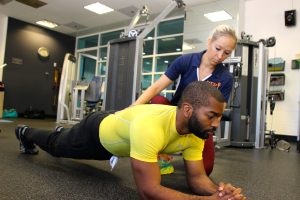Proper form should be the one constant amidst the many styles and methods of personal training. Every personal trainer has his or her own way of working with clients and catering to the individual preferences.
Some clients thrive in a boot-camp environment while others prefer and succeed best under gentler conditions. Whatever your or your clients’ preferences, prioritization of proper form should come before intensity, duration, and volume of training.
Yes – identifying the training “sweet spot” for clients is an important aspect of helping clients achieve their goals, it will never trump the execution of any exercise using proper form.
Why Proper Form
 The body is comprised of a complex series of levers and fulcrums and joints are meant to move in predetermined directions. Training a client to execute proper form in all movements means the body’s joints are protected and the desired muscle group is targeted.
The body is comprised of a complex series of levers and fulcrums and joints are meant to move in predetermined directions. Training a client to execute proper form in all movements means the body’s joints are protected and the desired muscle group is targeted.
Using improper form will intensify already present weaknesses or imbalances and will, most likely, result in injury. An injured client won’t make progress.
Know When to Say When
Part of guiding clients towards success is teaching them how to identify their threshold. As trainers, we also need to become adept at observing body mechanics and stopping an exercise when form is compromised. This includes teaching clients to avoid the use of momentum to help him or her complete the movement.
Examples of Improper Form
Every exercise has the potential to be done incorrectly; however, these are some of the most common errors observed.
1. Squats – knees bowing out or caving in or failing to press through the heels
2. Crunches – client does not sustain a posterior pelvic tilt and/or pulls on the neck
3. Plank – hips drop or hips are elevated
4. Bench press – arching the back, bouncing the bar off the chest, or lifting the feet off the ground
5. Lunges – pushing off the front toe instead of the heel
6. Pushups – failing to maintain a neutral spine/straight line from head to toe
7. Russian twist – rounding the back or slouching forward
8. Bent-over-row – rounding the shoulders forward
Fixing Poor Form
As a trainer, you can employ a variety of best practices when it comes to cueing form.
• Always demonstrate the exercise first before asking your client to perform it.
• Communicate with clients during exercises and asking probing questions such as “where do you feel the stress” or “are you feeling it here” and point to the area.
• If a client answers a question in opposition of what you would expect, stop the exercise and/or ask to adjust their body for them.
• If momentum is an issue, lower the weight.
Finally, aim to learn as much as you can about the lever systems in the body by studying anatomy and the origins and insertions of the muscles. Gaining a working understanding of how muscles attach to bone will provide you with in-depth knowledge of how to correct imbalances and weaknesses in your clients.
[info type=”facebook”]Join the conversation on the NFPT Facebook Community Group.[/info]
Dr. Erin Nitschke, NFPT-CPT, NSCA-CPT, ACE Health Coach, Fitness Nutrition Specialist, Therapeutic Exercise Specialist, and Pn1 is a health and human performance college professor, fitness blogger, mother, and passionate fitness professional. She has over 15 years of experience in the fitness industry and college instruction. Erin believes in the power of a holistic approach to healthy living. She loves encouraging her clients and students to develop body harmony by teaching focused skill development and lifestyle balance. Erin is also the Director of Educational Partnerships & Programs for the NFPT. Erin is an editorial author for ACE, IDEA, The Sheridan Press, and the Casper Star Tribune. Visit her personal blog at belivestaywell.com

